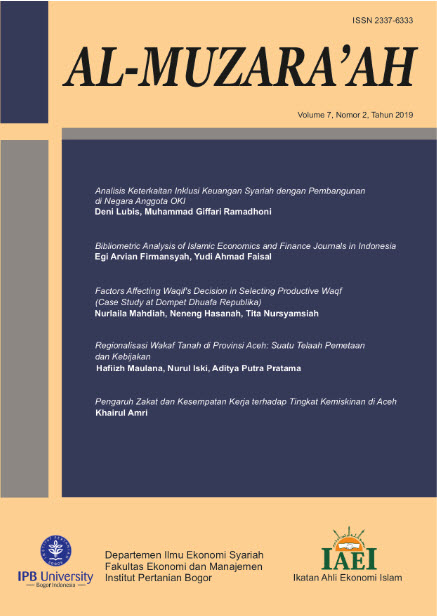Regionalisasi Wakaf Tanah di Provinsi Aceh: Suatu Telaah Pemetaan dan Kebijakan
Main Article Content
Abstract
This research was conduct to identify the regionalization of land waqf in Aceh Province based on compilation of waqf data sourced from Sistem Informasi Wakaf (Siwak) The Ministry of Religious Affairs of the Republic of Indonesia. This research is interesting because there are no studies that have conducted mapping land of waqf. Mapping of potential land waqf in Aceh Province wants to offer an easy solution in terms of inventory potential region as making policy. The methode used by descriptive analysis which is also elaborated with Geographic Information System analysis (GIS) tool. Based on the results of the GIS mapping conducted in the area of land waqf in Aceh Province, land waqf is concentrated in North Aceh District covering 63% of the distribution waqf land in Aceh. However, land Waqf has not been synergy optimally managed with the process of certifying legality. Regionalization needs two types of policy schemes; those are nazhir and waqif perspectives. Nazhir perspective policy is carried out in the scheme of forming professional waqf nazhir institutions. Meanwhile, the waqf perspective policy needs to be carried out with spatial planning and waqf area with the establishment of an Aceh waqf management body regulated in a Perda/Qanun.
Downloads
Article Details

This work is licensed under a Creative Commons Attribution-ShareAlike 4.0 International License.
Author(s) who published in this journal agree to following terms:
- Authors understand and agree that copyright of manuscripts published are held by Al-Muzara'ah. The statement to release the copyright to Al-Muzara'ah is stated in form CTA (link doc).
- Copyright encompass exclusive rights to reproduce, to distribute, and to sell any part of the journal articles in all form and media.
This work is licensed under a Creative Commons Attribution-ShareAlike 4.0 International License (CC BY-SA) where Authors and Readers can copy and redistribute the material in any medium or format, as well as remix, transform, and build upon the material for any purpose, but they must give appropriate credit (cite to the article or content), provide a link to the license, and indicate if changes were made. If you remix, transform, or build upon the material, you must distribute your contributions under the same license as the original.
References
Almizan, A. (2016). Pembangunan ekonomi dalam perspektif ekonomi Islam. Maqdis: Jurnal Kajian Ekonomi Islam, 1(2), 203-222.
Anas, A., & Ryandono, M. N. H. (2017). Wakaf produktif dalam pemberantasan kemiskinan melalui pemberdayaan ekonomi di Yayasan Nurul Hayat Surabaya. Jurnal Ekonomi Syariah Teori dan Terapan, 4(3), 253.
Az-Zuhaili, W. (2011). Fiqih Islam Wa Adillatuhu terj. Abdul Hayyie al-Kattani, dkk. Jakarta (ID): Gema Insani.
[BPS] Badan Pusat Statistik Aceh. (2018). Aceh dalam Angka 2018. Aceh: BPS Provinsi Aceh.
[BWI] Badan Wakaf Indonesia. (2010). Pencanangan Gerakan Nasional Wakaf Uang oleh Presiden Republik Indonesia. Jakarta (ID), BWI.
Djunaedi, A. & Al-Muin, N. (2015). Legalisasi status tanah bangunan masjid menjadi wakaf: Upaya memberikan perlindungan atas tanah-tanah wakaf. Al-Awqaf: Jurnal Wakaf dan Ekonomi, 8(1), 51-59.
Fakhruddin, F. (2018). Pemetaan tanah wakaf di Kabupaten Karawang. Harmoni, 17(1), 152-171.
Huda, M. (2013). Mekanisme penciptaan tata kelola wakaf kreatif di Indonesia. Al-Awqaf: Jurnal Wakaf Dan Ekonomi Islam, 8(1), 94-107.
Huda, N., et al. (2015). Prioritas solusi permasalahan wakaf di Provinsi Jawa Barat dengan metode ANP. Al-Awqaf: Jurnal Wakaf dan Ekonomi, 8(1), 60-72.
Ibrahim, A. (2015). Prospek pemanfaatan tanah wakaf di Aceh: Suatu analisis untuk sektor pendidikan. Human Falah: Jurnal Ekonomi dan Bisnis Islam, 2(2), 38-58.
Indraprahasta, G. S. (2013). The potential of urban agriculture development in Jakarta. Procedia Environmental Sciences, 17, 11-19.
[Kemenag] Kementerian Agama. (2013). Paradigma Baru Wakaf di Indonesia. Jakarta (ID), Kemenag.
[Kemenag] Kementrian Agama. (2017). Kementerian Agama dalam Angka 2017. Jakarta (ID), Kemenag.
Kencana, U. (2015). Konsep hukum pengelolaan dan pengembangan wakaf uang berbentuk saham dalam Perseroan Terbatas. Al-Awqaf: Jurnal Wakaf dan Ekonomi, 8(1), 1-16.
Maulida, R., & Ridwan, R. (2017). Analisis akuntabilitas pengelolaan waqaf pada baitul mal provinsi aceh. Jurnal Ilmiah Mahasiswa Ekonomi Akuntansi, 2(4), 162-174.
Prihatini, F. (2005). Hukum Islam Zakat dan Wakaf. Jakarta: Kerjasama Penerbit Papas Sinar Mentari dengan Badan Penerbit Fakultas Hukum Universitas Indonesia.
Sedar, A. (2015). The Impact of Waqfs on Economic Development of the Ottoman Empire: The Case of Western Thrace, Research Gate.
[Siwak Kemenag] Sistem Informasi Wakaf Kementerian Agama. (2018). Grafik Jumlah Tanah Wakaf. Tersedia dalam pada http://siwak.kemenag.go.id/grafik_jumlah_tanah_wakaf.php. Diakses pada tanggal 09 Oktober 2019.
Susanto, H. (2016). Eksistensi dan peran ekonomis harta wakaf. Hunafa: Jurnal Studia Islamika, 13(2), 316-342.
Sutami. (2012). Perkembangan wakaf di Indonesia. Al-Awqaf: Jurnal Wakaf dan Ekonomi, 5(2), 13-21.
Tiswarni, & Hidayat, R. (2016). Kontribusi wakaf kapal nelayan untuk pemberdayaan ekonomi masyarakat. Al-Awqaf : Jurnal Wakaf dan Ekonomi, 9 (2), 96-117.

